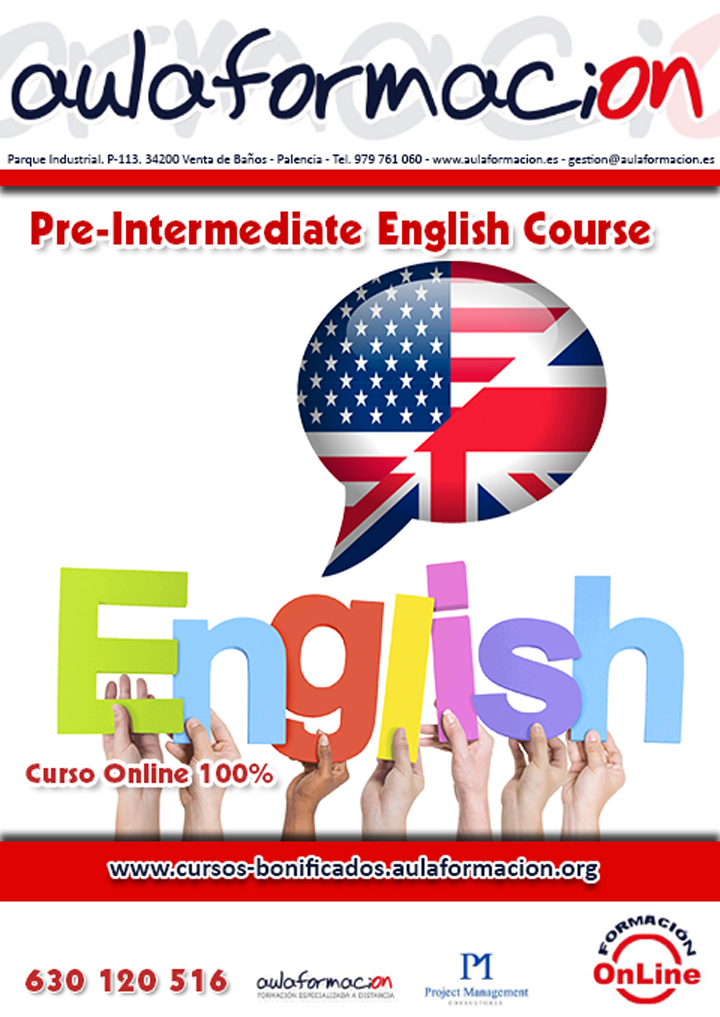Descripción
Pre-intermediate english course
OBJETIVOS
Resultados de aprendizaje
Los estudiantes deben ser capaces de gestionar otros usos del presente continuo para situaciones futuras , así como el presente simple para situaciones fuera de tiempos . Se deben identificar y utilizar los verbos de estado . También deben ser capaces de diferenciar estructuras tales como los del presente perfecto simple del continuo , así como las diferentes formas de tiempo futuro . Deben reconocer y utilizar las cláusulas condicionales y la voz pasiva. También tendrán ejercicios de escuchar (y hablar) en diferentes situaciones como una manera de ejercer funciones comunicativas en Inglés para mejorar su comprensión .
General Goals
The students should be able to manage other uses of the present continuous for future arrangements, and for annoying habits as well as the present simple for external timetables. They should identify and use the state verbs. They should also be able to differentiate structures such as those of the present perfect simple from the continuous, as well as the different forms of the future tense. They should recognize and use the conditional clauses and the passive voice. They will also have exercises of listening and speaking in different situations as a way of exercising communicative functions in English to improve their understanding.
DURACION
25 Horas
DESTINATARIOS:
Estudiantes iniciados en el proceso de aprendizaje del idioma inglés.
Metodología
El Pre-intermediate english course se imparte en la modalidad a distancia bajo metodología de aprendizaje E-Learning. La acción tutorial se desarrollará completamente a través del Campus Virtual de la Plataforma.
El Modelo de formación a distancia está basado en una combinación de una acción tutorial constante y autoaprendizaje mediante recursos didácticos multimedia e interactivos.
Según lo anterior, la formación a distancia se basa en un modelo de formación que no requiere la presencia física del alumno en una clase o centro de formación tradicional. Esto le permite compatibilizar el aprendizaje con otras actividades.
Además, el alumno es quien establece sus horarios, el ritmo y el lugar de realización del curso, aunque dentro del Plan de Trabajo establecido.
El autoaprendizaje es necesario a través del estudio y el trabajo individual.
Más información sobre el sistema de bonificación
Formación bonificada
https://cursos-bonificados.aulaformacion.org/formacion-bonificada/
Fundación Estatal para la Formación en el Empleo (FUNDAE) y el sistema de bonificación
https://www.fundae.es/empresas/home/como-bonificarte
PROGRAMA
1. OTHER USES OF PRESENT SIMPLE AND CONTINUOUS
• The verb to be in affirmative sentences.
• The verb to be in negative sentences
• The verb to be in questions. Question words.
• Adjectives
2. STATE VERBS
• The simple present tense with other verbs..
• Daily routines and habits.
• Speaking exercises
3. THE PRESENT PERFECT TENSE
• The present perfect ( Simple)
• Unfinished time.
• A past action reflected in the present.
• The use of since, just already, for.
• The particular use of been and gone
4. THE PRESENT PERFECT CONTINOUOS
• The Present Perfect Continuous.
• Focus on the activity and its time rather than on the result.
• Contrasting present perfect simple and present perfect continuous.
• Questions with How ever and How long
5. THE PAST PERFECT TENSE
• The past perfect Tense:
• Two actions in the past one action completely finished before the other. The use of before , after, by the time, when
6. THE FUTURE TENSE ( WILL)
• Decisions in the moments of speaking.
• Possibility in the future.
• Promises.
• Invitations.
• Facts in the future.
7. THE FUTURE TENSE ( BE+ GOING TO+ VERB)
• Certainty in the future.
• Personal plans in the future.
• Differences between the future with going to and present continuous for future arrangements.
8. CONDITIONAL CLAUSES (1)
• The first conditional clause if + simple tense + will + bare verb to indicate possibility
• The use of there is are/ there was were to describe.
9. CONDITIONAL CLAUSE (2)
• The second conditional clause to refer to improbable situations:
• If + simple past + would + bare verb
10. CONDITIONAL CLAUSE (3)
• The third conditional clause to refer to unreal situations. We talk about an event that did not occur in the past:
• If + had + past participle + would + have + past participle.
11. PASSIVE VOICE IN PRESNT SIMPLE, PRESENT PROGUESSIVE AND PRESENT PERFECT
• Passive Voice in the Present Simple am /are/is + past participle
• Passive Voice in the Present Progressive Form am/are/is + being + past participle
• Passive voice in the Present Perfect Tense Have /has/ + been + Past Participle
12. MIXED TENSES
• To practice different texts and exercises in which the students should identify different tenses within a text.
13. THE USE OF HOPE AND WISH
• Hope and Wish
14. THE PARTICULAR USE OF THE VERBS DO AND MAKE
• DO vs. MAKE
15. CONFUSING VERBS TELL AND SAY
• Differences between Tell and Say






